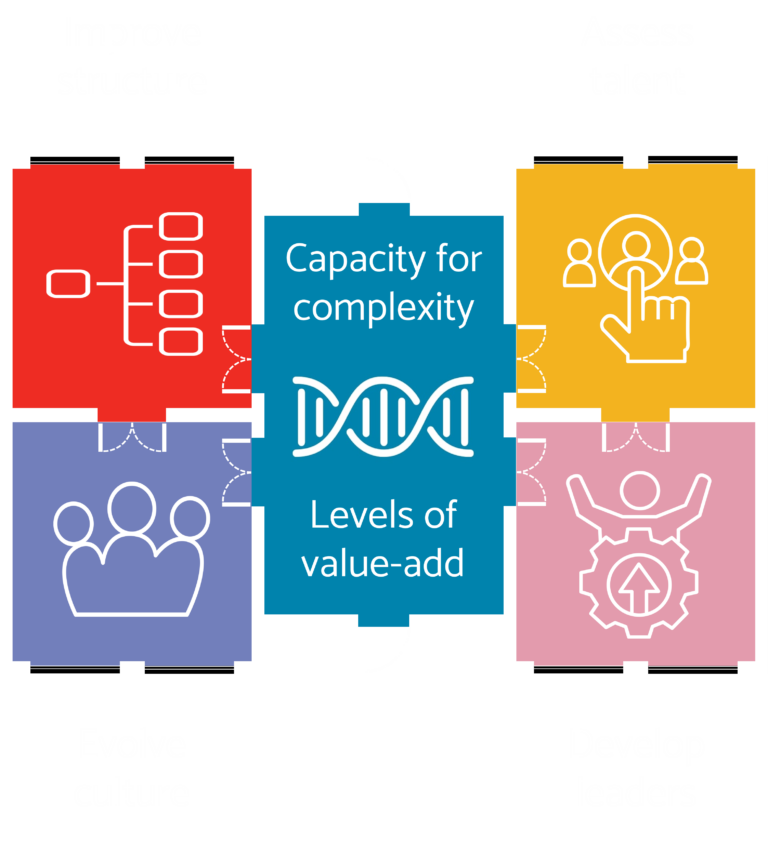
People who work for you add value by making decisions about achieving the goals you set while effectively using the resources you entrust them with.
People make these decisions based on their internal ‘maps of the world.’ Each map is unique, but all maps fall into a few distinct types of Capacity for Complexity.
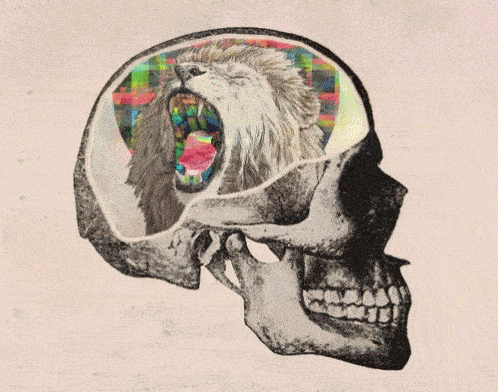
Understanding these types enables you, as a business founder, CEO or investor, to do a much better job than your competitors in putting the right people in the right roles.
The right roles. You design your organisations so that each layer of reporting is aligned with a specific type of capacity for complexity and adds unique value to decision-making. We call these natural levels of work, aligned with types of human capacity for complexity in a DNA-like double helix, Levels of Value-Add.
You end up with a flatter structure, faster decision-making, shorter time to market, less micromanagement and minimum-sufficient G&A costs.
The right people. As part of your recruitment, succession planning and leadership development, you first and foremost assess capacity for complexity: the most fundamental factor of leadership success, especially in senior roles.
For senior-level external recruitment, we can support your decision-making via independent evaluation of candidates' leadership potential using specialised assessment tools.
For evaluation of existing team members, we can train your team in the methodology of Capability Assessment by Line Managers, proven to be the most reliable way of evaluating talent within the organisation.
You end up with a higher success rate in key appointments and a vastly improved fit between roles and people across the organisation, leading to an increase in engagement and productivity.

What is the difference between a house and a home? A house is the combination of ‘hard’ elements: structures, systems and technology. A home, on the other hand, is all about ‘soft’ factors: psychological safety, belonging, trust, sense of shared identity and purpose…
Both ‘house’ (organisation) and ‘home’ (people and culture) are necessary and interdependent. Most advisors focus on one or the other. Very few can do both. 3A Group’s proposition integrates BOTH the ‘house’ (core complexity, levels of value-add, organisation design) AND the ‘home’ (talent evaluation, leadership development, culture building) as interconnected parts of a holistic approach.
Capacity for complexity and levels of value-add have been researched for 50+ years, resulting in 2,000+ published studies, including 130+ PhD dissertations.1
With little publicity, hundreds of leading organisations worldwide have been using these research insights as a backbone of their organisational and leadership development.2 Notable examples include Unilever, Tesco, Rio Tinto, ArcelorMittal, Holcim, the International Red Cross and the US Army.
Founders, CEOs and investors of mid-cap and smaller companies often lack the resources to develop this level of specialised insight internally, despite the immense benefits it can bring. At 3A Group, we are committed to bridging this gap.
Having used H.O.M.E. to benefit companies operating in a dozen sectors, from mining to game design, and employing from 75 to 75,000 people, we are dedicated to helping your business, whatever its current size, unlock its full potential.
Our goal:
Help you fully realise your own potential, using the businesses you build as vehicles for this realisation.
Concerns we aim to resolve:
Sophisticated investors know that typical approaches to managing “human capital” are inefficient. This understanding is backed up by research:
Our goal:
As a 'human-capital-partner-on-demand', we help you beat the market via optimised organisation design and talent deployment across your portfolio companies (portcos).
Concerns we aim to resolve:
Our goal:
Help you implement your strategy and leave a lasting legacy. While supporting yourself, we also help your head of Human Resources transform your company’s approach to attracting and developing talent into a major source of competitive advantage.
Concerns we aim to resolve:

We have used H.O.M.E. to help over 30 companies in a dozen countries and sectors.
Outcomes include:
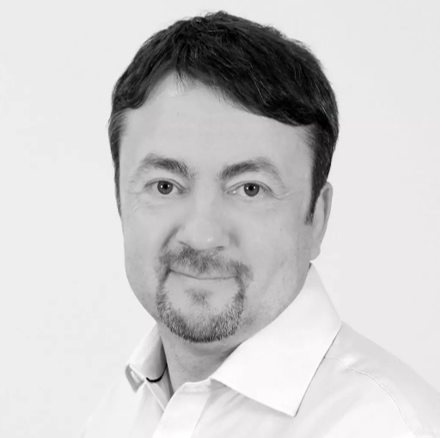
Ex Heidrick & Struggles and L'Oréal.
INSEAD MBA with 30 years' experience.
Used H.O.M.E. principles and tools to help 30+companies in 12 sectors with 75 to 75,000 staff.
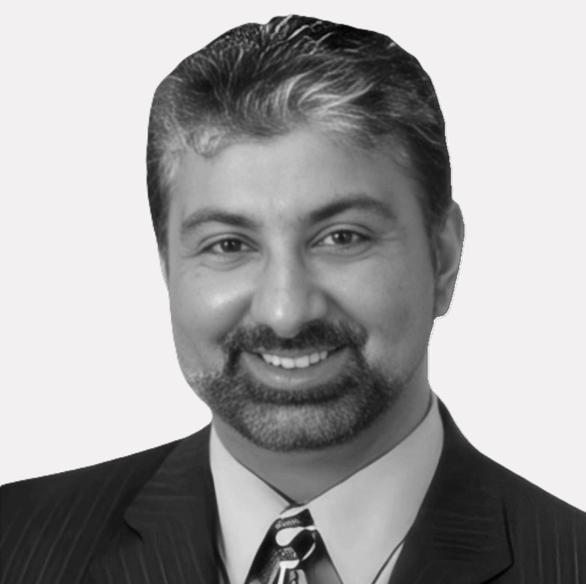
Ex Bioss and DDI (Development Dimensions International).
University of Leeds Economics graduate with 30 years' global experience.
Co-author of Humanizing the Corporation: A Regenerative Leadership Playbook.
Balances client work in organisational design, governance and executive coaching across industries with pro-bono development support for marginalised communities.
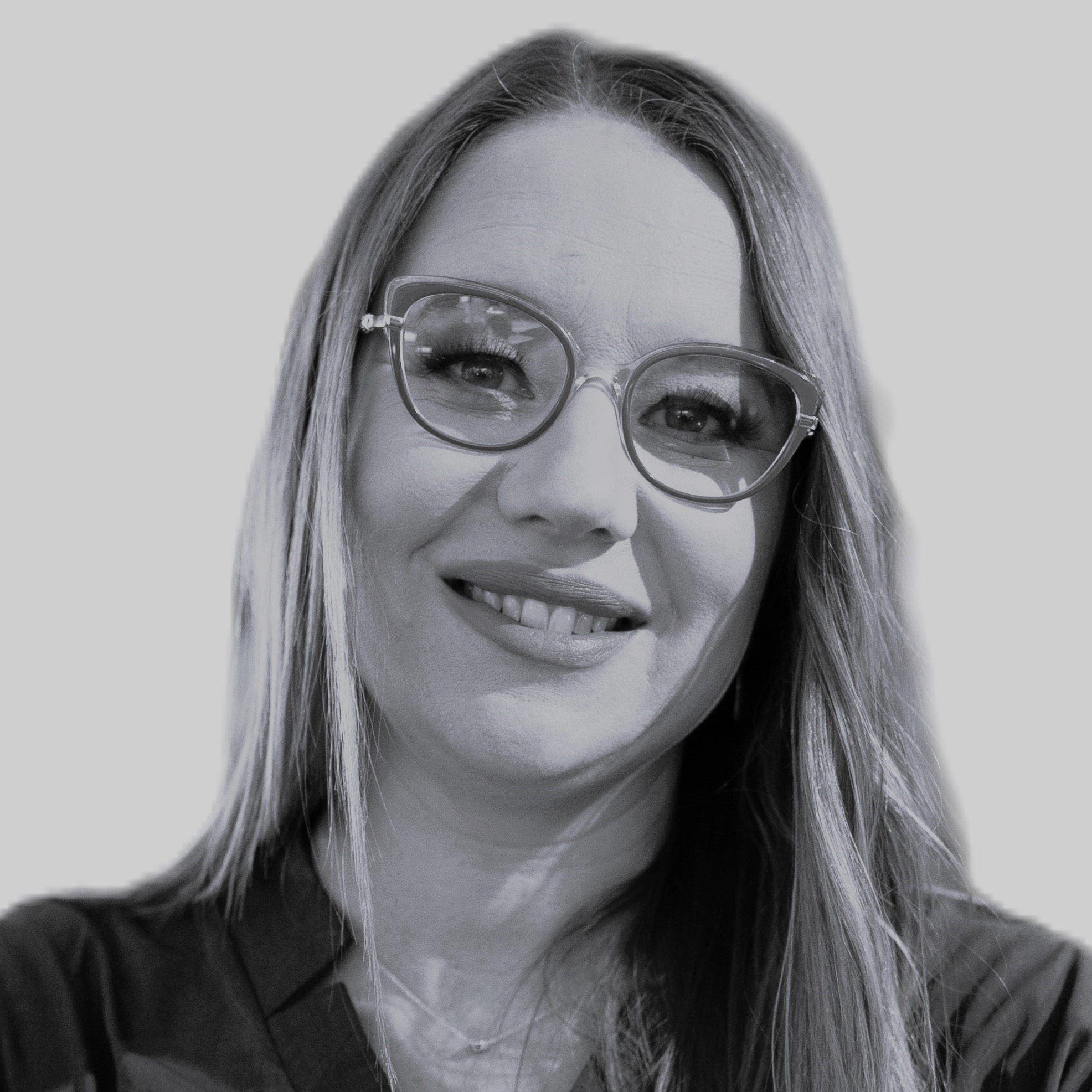
MA Industrial Organisational Psychology with 25 years of experience.
Registered Industrial Organisational Psychologist.
Our engagements focus on capturing high-impact opportunities, addressing root causes of issues, laying systemic cornerstones and building the client’s internal capabilities in line management and Human Resources. This approach does not require scores of junior consultants crowding client sites for weeks.
For large-scale, multidisciplinary, multinational and time-critical projects, we draw upon senior-level specialist expertise from a global network of advisors in strategy, organisation, and leadership alignment. Most often, we collaborate with closely affiliated, long-standing colleagues from Anaka Partners, VALPEO, the True North alliance and the Systems Leadership network.
This way, our clients benefit from a combination of senior-level expertise, global reach, speed and cost-effectiveness.
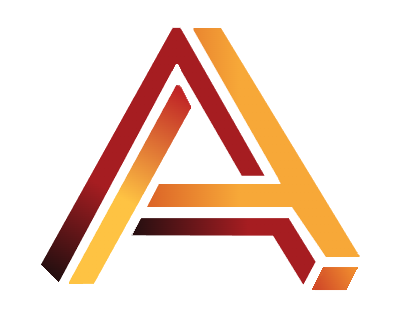
Lorette is a registered Industrial/ Organisational Psychologist. She is passionate about identifying trends and patterns in individual and organisational behaviour. Being accredited in a vast array of proven psychometric tools, she can provide insight and clarity for selection and development, training facilitation and culture optimisation. She also provides coaching and facilitates workshops that she has developed on psychological safety, team cohesion, and improving decision-making.
Lorette has committed herself to understanding the fit between people and the contexts in which they can thrive and become the best versions of themselves. As the only Valpeo™ Accredited Partner working in Africa, she aims to leverage her understanding of leadership in context and vertical development towards the transformation of organisations on the continent and globally.
In her free time, she is the principal flautist of a symphony orchestra, a proud member of the Pink Freud quiz team and enjoys endurance hiking in interesting places.
If you are new in your role, we help you very quickly diagnose the readiness of your senior leadership team, your talent bench and your overall organisational structure to deliver your strategy.
If you need to make leadership changes, we help you avoid costly mistakes via rigorous profiling of senior leadership positions and in-depth assessment of both external and internal candidates, with a uniquely powerful focus on ensuring fit between role complexity and incumbent potential.
Once your senior leadership team is in place, we work together to enhance the company’s organisation design, aligning it with strategic objectives and making it more efficient, resilient and scalable. Alignment with the Levels of value-add helps flatten the structure and gear each organisational layer towards adding unique value.
Once the fundamentals of science-based organisation design are in place, we shift focus to helping you build a leadership pipeline. To this end, we will train your managers and HR in the methodology of Capability Assessment by Line Managers. An extensive study14 found CALM to be a uniquely robust way of assessing potential of employees at any level within an organisation.
Next we focus on upgrading the quality of leadership across the company. We do that via a series of workshops where managers at all level are upskilled in the application of selected universal leadership tools, such as task assignment, monitoring and coaching.
Our next area of focus is on helping you evolve the organisational culture. First we diagnose the culture you have and help you define the culture you want. We then support you in activating the levers of cultural change - systems, symbols and leadership behaviours - to move your culture in the desired direction.
As an “on-demand human capital partner”, we start by helping you define the Level of Value-Add of your investment thesis. We can then support you and your portco at all stages of the investment cycle.
At the due diligence stage, we can conduct an in-depth assessment of the senior leadership team’s capability to deliver on your investment thesis. The results will inform your decisions on the necessary leadership changes and their optimal timing.
We can also carry out a rapid and non-invasive due diligence of the target’s organisation structure. This study aims to highlight risks for the delivery of your investment thesis and pinpoint potential areas of G&A cost savings.
During the first months post-investment, we help you secure the talent that the portco needs to deliver on your investment thesis. This work has two sides:
Our talent assessment is different from the typical approaches12 used by PE investors. We focus a lot more on evaluating the candidates’ capacity for complexity, for two reasons:
Later in the investment lifecycle, our focus shifts to supporting the portco’s CEO and senior leadership team in building a competitive advantage through a systemic approach to managing the company’s talent and developing its culture.
Our engagement often starts with appreciating your own leadership journey. This appreciation is built on a deep study of three personal dynamics: capacity for complexity, value orientation and behavioural preferences.
You gain unique insights about the scale and complexity of the businesses that you will be best positioned to lead now and in the future. The appreciation may also inform your thinking about the best timing for transitioning out of operational control and starting your next venture.
You also gain insights about how your value orientations and behavioural preferences may help or hinder the full realisation of your potential, what kind of organisational culture you are likely to create around you, how you can use your values to strengthen the company's brand and how you can further enhance your effectiveness as a leader.
Subsequent steps of a founder's H.O.M.E. journey are often similar to the pathway taken by a forward-thinking CEO / Managing Director.
Kashmir brings 30 years of global expertise in organisational design, governance, and talent development, helping organizations align strategy, culture, and people. His approach addresses systemic barriers to performance while fostering accountability and collaboration.
An advocate for transformative leadership, Kashmir cultivates growth at the intersection of meaning, values, and strategy. He has led large-scale transformation initiatives for flagship companies in a range of industries, including mining (BHP Billiton), automotive (Toyota), banking (Barclays), consumer goods (Procter & Gamble), retail (Walmart), healthcare, and more.
Kashmir’s career includes roles as CEO of Bioss, where he revitalised a global brand rooted in organizational theory, and as a senior consultant at DDI, supporting clients with strategic alignment, team building, and culture change. He co-founded The True North, an advisory firm, delivering tailored solutions such as streamlining structures at British banks, pioneering agile designs for U.S. media firms, and optimizing cross-functional teams in global enterprises.
Kashmir believes in self-less service, so when he is not flying in to coach and develop executives, he is providing the same development support pro-bono through the Refiner’s Hub platform to people who have been downtrodden, marginalized and forgotten, such as the aged, aboriginals, refugees, immigrants, the homeless, abused and abandoned.
Kashmir regularly engages with thought leadership on culture and governance. Most recently, he co-authored Humanizing the Corporation: A Regenerative Leadership Playbook which presents seven key principles to help organisations transition toward a more humane and sustainable way of operating.
In his free time, Kashmir is an avid gardener: planting, tending, harvesting and enabling his family to enjoy fresh organic herbs, fruits and vegetables. Gardening is one of his three favourite forms of meditation, the other two being tantric meditation and writing poetry. His poem about being on the brink of death during an asthma attack called “Sailboat” won the Leeds Writers Circle Amateur Poetry Award. One of his love poems, “Unravelled”, was awarded second prize at the Arvon Foundation Poetry Competition. Links to his poetry pages on Facebook and Instagram include insights into how lessons from the garden and nature can be applied to developing leaders and institutions.

Sector: Banking
Client: A retail bank specialised in consumer lending with 10,000 employees.
Context: After a period of strong growth, the bank’s strategy shifted towards defending market share and profitability in toughening market conditions.
What we did:
We started with an organisation structure diagnostic and identified managerial roles that were adding limited value to the work of their direct reports.
We then designed a streamlined structure, aligning organisational layers with Levels of value-add and removing two extraneous layers of reporting.
After the restructuring we trained the bank’s management and HR in Capability Assessment by Line Managers (CALM).
Business Outcomes:

Sector: Business services
Client: An IT services and software development company.
Context: Creation of a new outsourced HR business unit growing from 45 to 700 staff within 20 months.
What we did:
We started by designing a lean organisation structure with only four value-adding reporting layers and with clear cross-functional role relationships.
We then helped define long-term objectives and key results for each senior managerial role. We further trained all managers in Universal leadership tools, applicable at all levels in every function.
Finally, we trained management in the methodology of Capability Assessment by Line Managers and cross-validated this internal assessment via independent evaluation of key team members’ capacity for complexity.
Business outcomes:
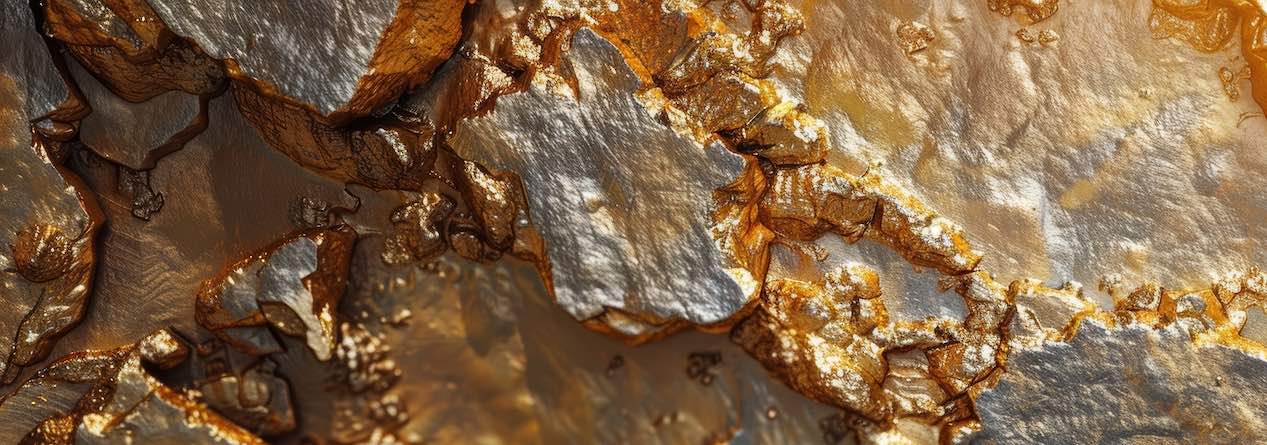
Sector: Mining & Metals
Client: Gold mining group with assets in 8 countries and 2,700 staff.
Context: In advance of a share listing, the company needed to increase productivity while bringing G&A costs in line with international benchmarks.
What we did:
We started by workshop introducing the company’s senior leadership to principles of science-based management of organisation and talent.
Based on these principles, the organisational structure of most business units was significantly streamlined, reducing the number of organisational layers from 6-8 to 4.
We also carried out an independent assessment of capacity for complexity for over 300 internal successors and external candidates to key management roles in the business units and the corporate centre, with a focus on their mental agility.
Business outcomes in reorganised units:
Craddock C. Requisite Organization Annotated Bibliography. 6th edition. Global Organization Design Society, 2021.
Organizations on Public Record as Having Used Requisite Organization. Global Organization Design Society.
Survey of 1,700 companies by Development Dimensions International Leadership Transitions Report 2021.
Watkins M. The First 90 Days: Critical Success Strategies for New Leaders at All Levels, Boston: Harvard Business School Press, 2003.
Leadership IQ research of 20,000 new hires, quoted in Hire for Attitude, Forbes, December 2012
Heidrick & Struggles analysis of 20,000 executive appointments, quoted in Rise of a Headhunter Financial Times, March 30, 2009
Murphy M., “Leadership IQ study: Why new hires fail,” Public Management, 2005, Volume 88, Number 2
Wheeler P., Executive transitions market study summary report, The Institute of Executive Development, 2008
Results of talent pool evaluations comprising 4,400 people by PeopleFit (1995-2005).
Harding D., Rouse T. Human Due Diligence. Harvard Business Review, April 2007
Heel J., Kehoe C. Why Some Private Equity Firms Do Better Than Others. McKinsey Quarterly, February 2005
AlixPartners First Annual Private Equity Leadership Survey, 2015
Lindberg U. Predictability of Investment Performance and the Impact of the Level of CEO’s and Partners. Requisite Organization International Institute, 2011.
Clement S., Clement C. It’s All about Work: Organizing Your Company to Get Work Done. Woodlands: Organizational Design, 2015
Andrei's passion is about unlocking the hidden potential of people and organisations, leading to a level shift in performance. To achieve this, he uses research-based methods in four areas: organisational design, talent assessment, leadership development, and culture building.
Over 30 years, a winding working journey has taken Andrei from running operations for a franchise network of printshops in Russia to heading HR in Europe for a global software company. He learned the ropes of corporate HR management at L’Oreal and was steeped in executive search and leadership consulting at Heidrick & Struggles, Korn/Ferry and Odgers Berndtson. London has been his home base since 2001, after he graduated from INSEAD in France with an MBA focused on Organisational Behaviour.
Andrei's H.O.M.E. work started in 2012 when he discovered the uniquely powerful and underrated body of knowledge around capacity for complexity and levels of value-add. Since then, he's been fortunate to do H.O.M.E. work in 15 countries and help 30+ companies operating across 12 sectors and employing anywhere between 75 and 75,000 people, use elements of H.O.M.E. to create competitive advantage. Most of all, he has enjoyed making the industry leaders' methods available to midsized and smaller companies.
When not working with clients, Andrei likes exploring new research at the intersection of organisational theory and leadership psychology. His recreational time is shared between hill walks, design exhibitions, karaoke gatherings, space-saving home improvements, and making memories with his better half of over 30 years and their three mostly grown-up children.